MHS1101: Anatomy and Physiology Case Study Assignment
VerifiedAdded on 2023/01/16
|12
|2755
|64
Case Study
AI Summary
This document presents solutions to two anatomy and physiology case studies. The first case examines a 25-year-old man presenting with meningitis, focusing on the lumbar puncture procedure, including anatomical landmarks, needle insertion, patient positioning, and potential complications such as headaches. The second case involves a 14-year-old with a shoulder dislocation, exploring the gross anatomy of the shoulder joint, nerve damage, muscle functions, and the effects of humeral fractures. The document details the blood supply to the brain, including the circle of Willis, and the causes of intracranial hemorrhage. The solutions provide detailed anatomical explanations and address the clinical scenarios presented in the cases.
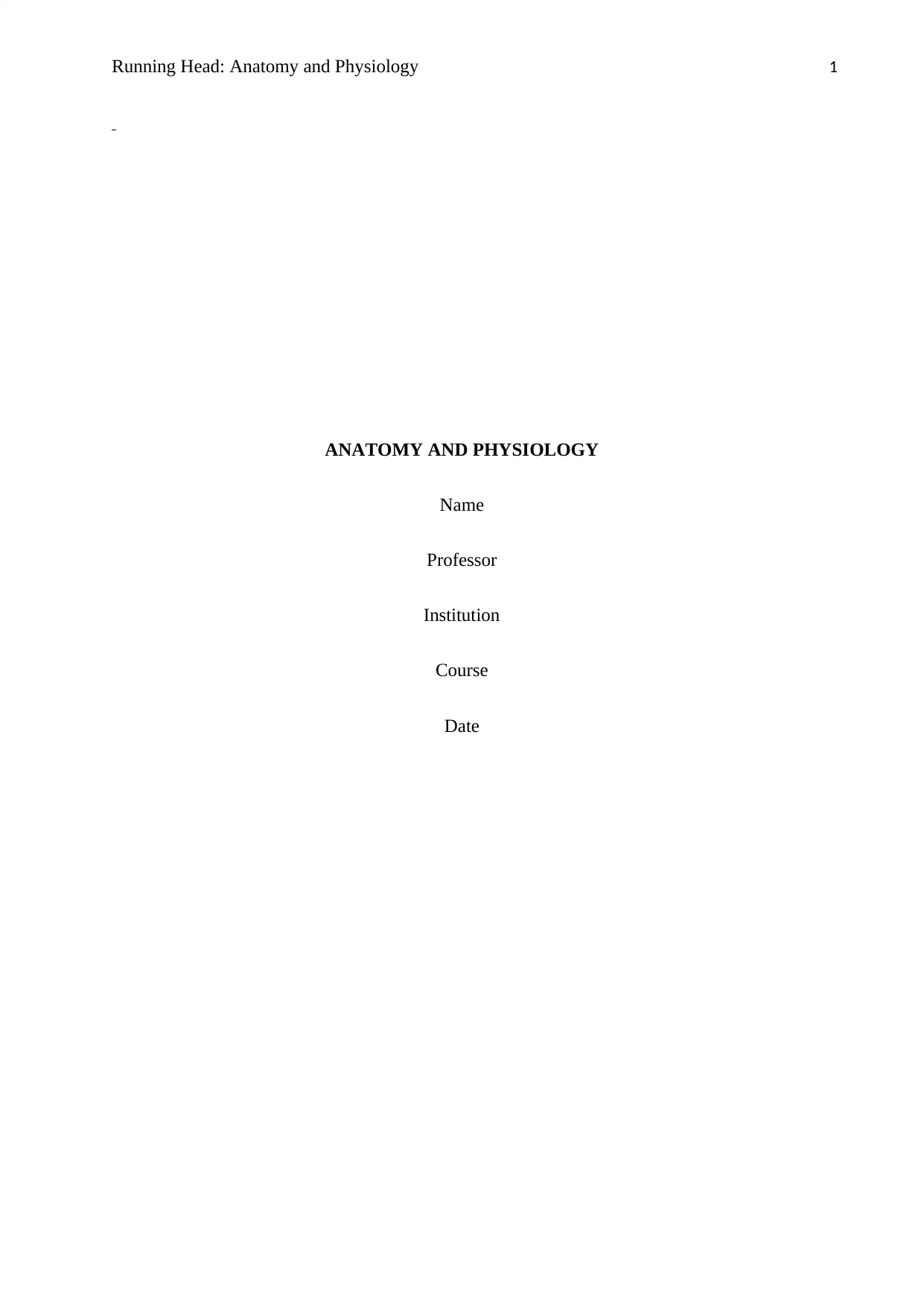
Running Head: Anatomy and Physiology 1
ANATOMY AND PHYSIOLOGY
Name
Professor
Institution
Course
Date
ANATOMY AND PHYSIOLOGY
Name
Professor
Institution
Course
Date
Paraphrase This Document
Need a fresh take? Get an instant paraphrase of this document with our AI Paraphraser
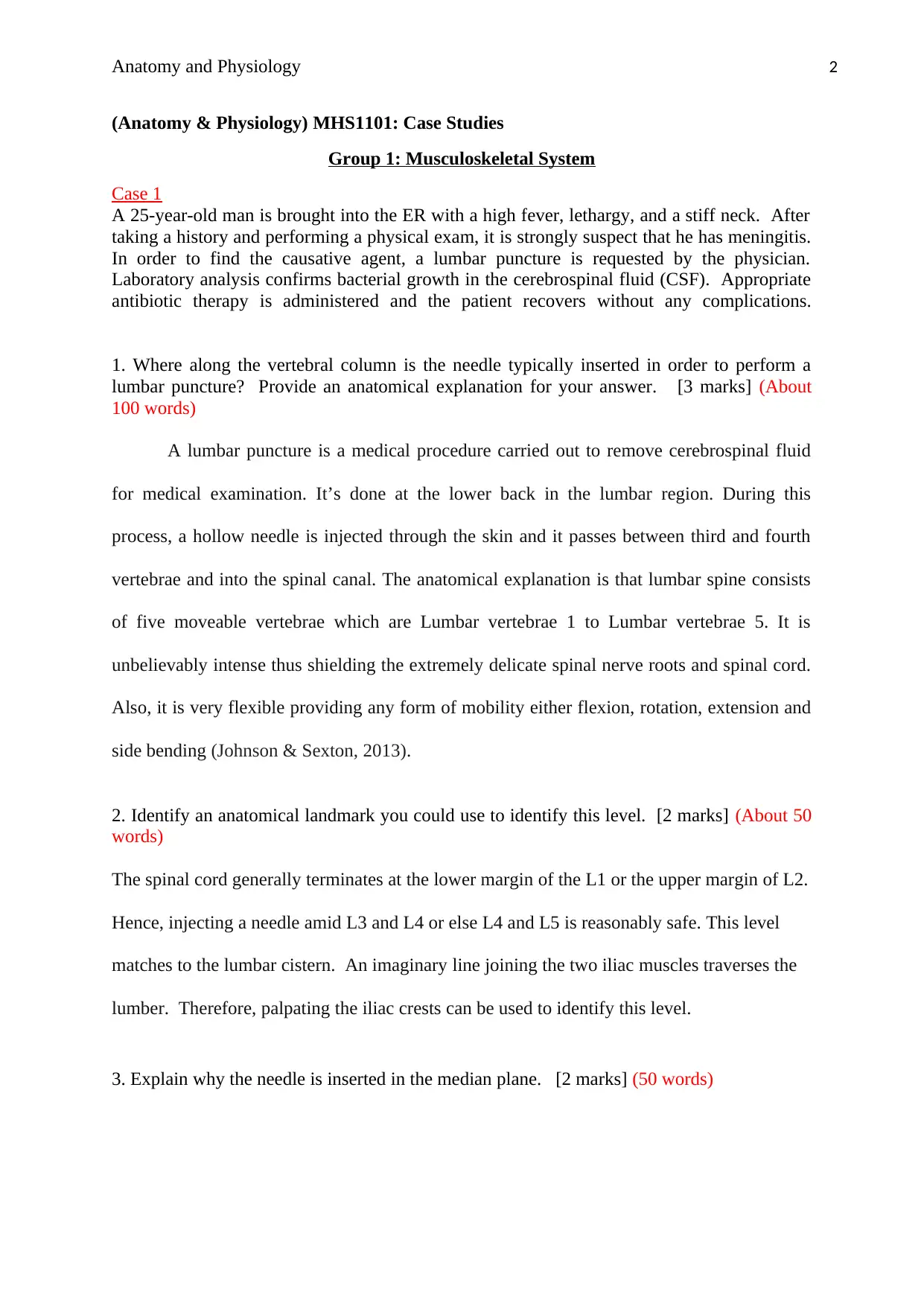
Anatomy and Physiology 2
(Anatomy & Physiology) MHS1101: Case Studies
Group 1: Musculoskeletal System
Case 1
A 25-year-old man is brought into the ER with a high fever, lethargy, and a stiff neck. After
taking a history and performing a physical exam, it is strongly suspect that he has meningitis.
In order to find the causative agent, a lumbar puncture is requested by the physician.
Laboratory analysis confirms bacterial growth in the cerebrospinal fluid (CSF). Appropriate
antibiotic therapy is administered and the patient recovers without any complications.
1. Where along the vertebral column is the needle typically inserted in order to perform a
lumbar puncture? Provide an anatomical explanation for your answer. [3 marks] (About
100 words)
A lumbar puncture is a medical procedure carried out to remove cerebrospinal fluid
for medical examination. It’s done at the lower back in the lumbar region. During this
process, a hollow needle is injected through the skin and it passes between third and fourth
vertebrae and into the spinal canal. The anatomical explanation is that lumbar spine consists
of five moveable vertebrae which are Lumbar vertebrae 1 to Lumbar vertebrae 5. It is
unbelievably intense thus shielding the extremely delicate spinal nerve roots and spinal cord.
Also, it is very flexible providing any form of mobility either flexion, rotation, extension and
side bending (Johnson & Sexton, 2013).
2. Identify an anatomical landmark you could use to identify this level. [2 marks] (About 50
words)
The spinal cord generally terminates at the lower margin of the L1 or the upper margin of L2.
Hence, injecting a needle amid L3 and L4 or else L4 and L5 is reasonably safe. This level
matches to the lumbar cistern. An imaginary line joining the two iliac muscles traverses the
lumber. Therefore, palpating the iliac crests can be used to identify this level.
3. Explain why the needle is inserted in the median plane. [2 marks] (50 words)
(Anatomy & Physiology) MHS1101: Case Studies
Group 1: Musculoskeletal System
Case 1
A 25-year-old man is brought into the ER with a high fever, lethargy, and a stiff neck. After
taking a history and performing a physical exam, it is strongly suspect that he has meningitis.
In order to find the causative agent, a lumbar puncture is requested by the physician.
Laboratory analysis confirms bacterial growth in the cerebrospinal fluid (CSF). Appropriate
antibiotic therapy is administered and the patient recovers without any complications.
1. Where along the vertebral column is the needle typically inserted in order to perform a
lumbar puncture? Provide an anatomical explanation for your answer. [3 marks] (About
100 words)
A lumbar puncture is a medical procedure carried out to remove cerebrospinal fluid
for medical examination. It’s done at the lower back in the lumbar region. During this
process, a hollow needle is injected through the skin and it passes between third and fourth
vertebrae and into the spinal canal. The anatomical explanation is that lumbar spine consists
of five moveable vertebrae which are Lumbar vertebrae 1 to Lumbar vertebrae 5. It is
unbelievably intense thus shielding the extremely delicate spinal nerve roots and spinal cord.
Also, it is very flexible providing any form of mobility either flexion, rotation, extension and
side bending (Johnson & Sexton, 2013).
2. Identify an anatomical landmark you could use to identify this level. [2 marks] (About 50
words)
The spinal cord generally terminates at the lower margin of the L1 or the upper margin of L2.
Hence, injecting a needle amid L3 and L4 or else L4 and L5 is reasonably safe. This level
matches to the lumbar cistern. An imaginary line joining the two iliac muscles traverses the
lumber. Therefore, palpating the iliac crests can be used to identify this level.
3. Explain why the needle is inserted in the median plane. [2 marks] (50 words)
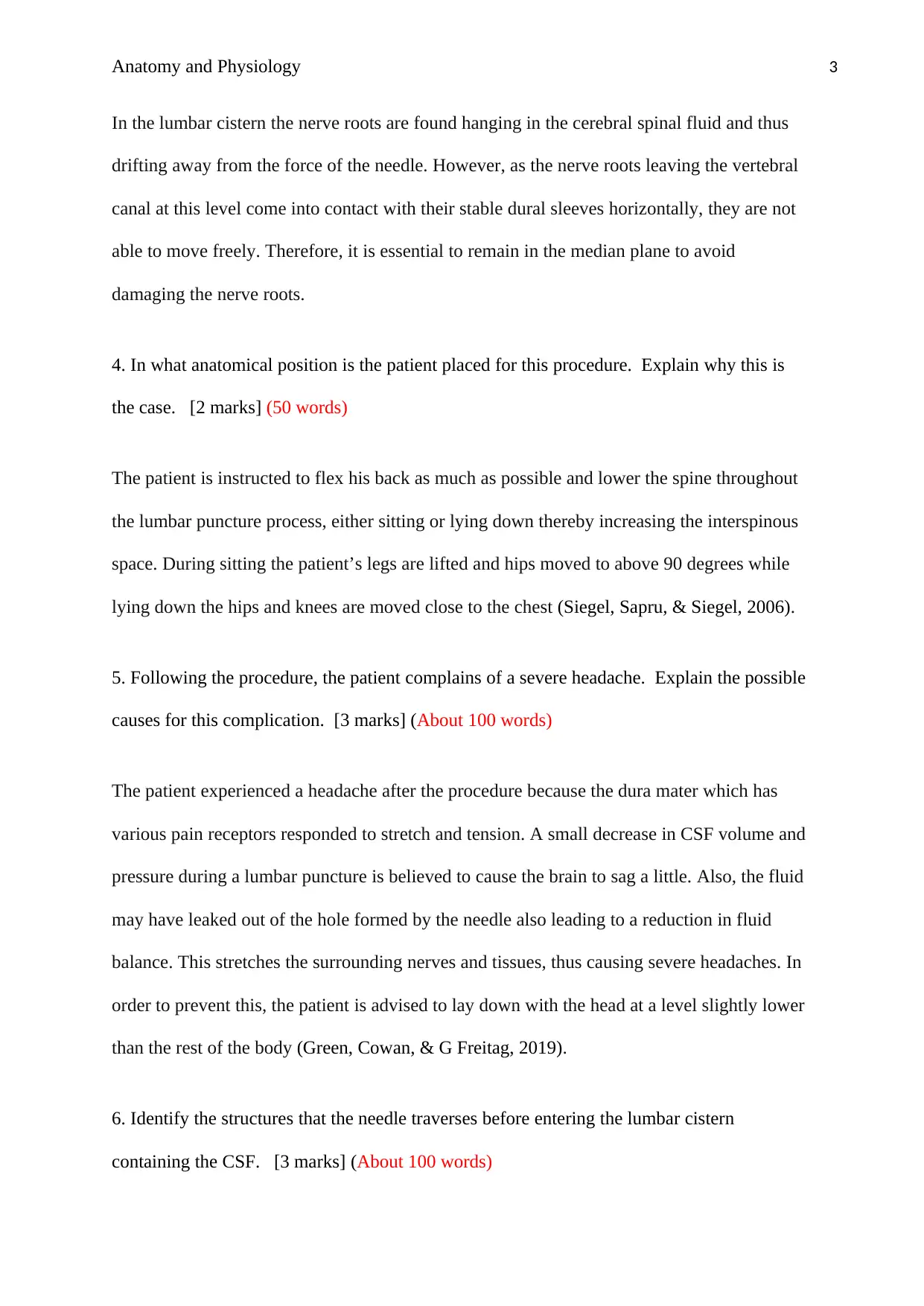
Anatomy and Physiology 3
In the lumbar cistern the nerve roots are found hanging in the cerebral spinal fluid and thus
drifting away from the force of the needle. However, as the nerve roots leaving the vertebral
canal at this level come into contact with their stable dural sleeves horizontally, they are not
able to move freely. Therefore, it is essential to remain in the median plane to avoid
damaging the nerve roots.
4. In what anatomical position is the patient placed for this procedure. Explain why this is
the case. [2 marks] (50 words)
The patient is instructed to flex his back as much as possible and lower the spine throughout
the lumbar puncture process, either sitting or lying down thereby increasing the interspinous
space. During sitting the patient’s legs are lifted and hips moved to above 90 degrees while
lying down the hips and knees are moved close to the chest (Siegel, Sapru, & Siegel, 2006).
5. Following the procedure, the patient complains of a severe headache. Explain the possible
causes for this complication. [3 marks] (About 100 words)
The patient experienced a headache after the procedure because the dura mater which has
various pain receptors responded to stretch and tension. A small decrease in CSF volume and
pressure during a lumbar puncture is believed to cause the brain to sag a little. Also, the fluid
may have leaked out of the hole formed by the needle also leading to a reduction in fluid
balance. This stretches the surrounding nerves and tissues, thus causing severe headaches. In
order to prevent this, the patient is advised to lay down with the head at a level slightly lower
than the rest of the body (Green, Cowan, & G Freitag, 2019).
6. Identify the structures that the needle traverses before entering the lumbar cistern
containing the CSF. [3 marks] (About 100 words)
In the lumbar cistern the nerve roots are found hanging in the cerebral spinal fluid and thus
drifting away from the force of the needle. However, as the nerve roots leaving the vertebral
canal at this level come into contact with their stable dural sleeves horizontally, they are not
able to move freely. Therefore, it is essential to remain in the median plane to avoid
damaging the nerve roots.
4. In what anatomical position is the patient placed for this procedure. Explain why this is
the case. [2 marks] (50 words)
The patient is instructed to flex his back as much as possible and lower the spine throughout
the lumbar puncture process, either sitting or lying down thereby increasing the interspinous
space. During sitting the patient’s legs are lifted and hips moved to above 90 degrees while
lying down the hips and knees are moved close to the chest (Siegel, Sapru, & Siegel, 2006).
5. Following the procedure, the patient complains of a severe headache. Explain the possible
causes for this complication. [3 marks] (About 100 words)
The patient experienced a headache after the procedure because the dura mater which has
various pain receptors responded to stretch and tension. A small decrease in CSF volume and
pressure during a lumbar puncture is believed to cause the brain to sag a little. Also, the fluid
may have leaked out of the hole formed by the needle also leading to a reduction in fluid
balance. This stretches the surrounding nerves and tissues, thus causing severe headaches. In
order to prevent this, the patient is advised to lay down with the head at a level slightly lower
than the rest of the body (Green, Cowan, & G Freitag, 2019).
6. Identify the structures that the needle traverses before entering the lumbar cistern
containing the CSF. [3 marks] (About 100 words)
⊘ This is a preview!⊘
Do you want full access?
Subscribe today to unlock all pages.

Trusted by 1+ million students worldwide
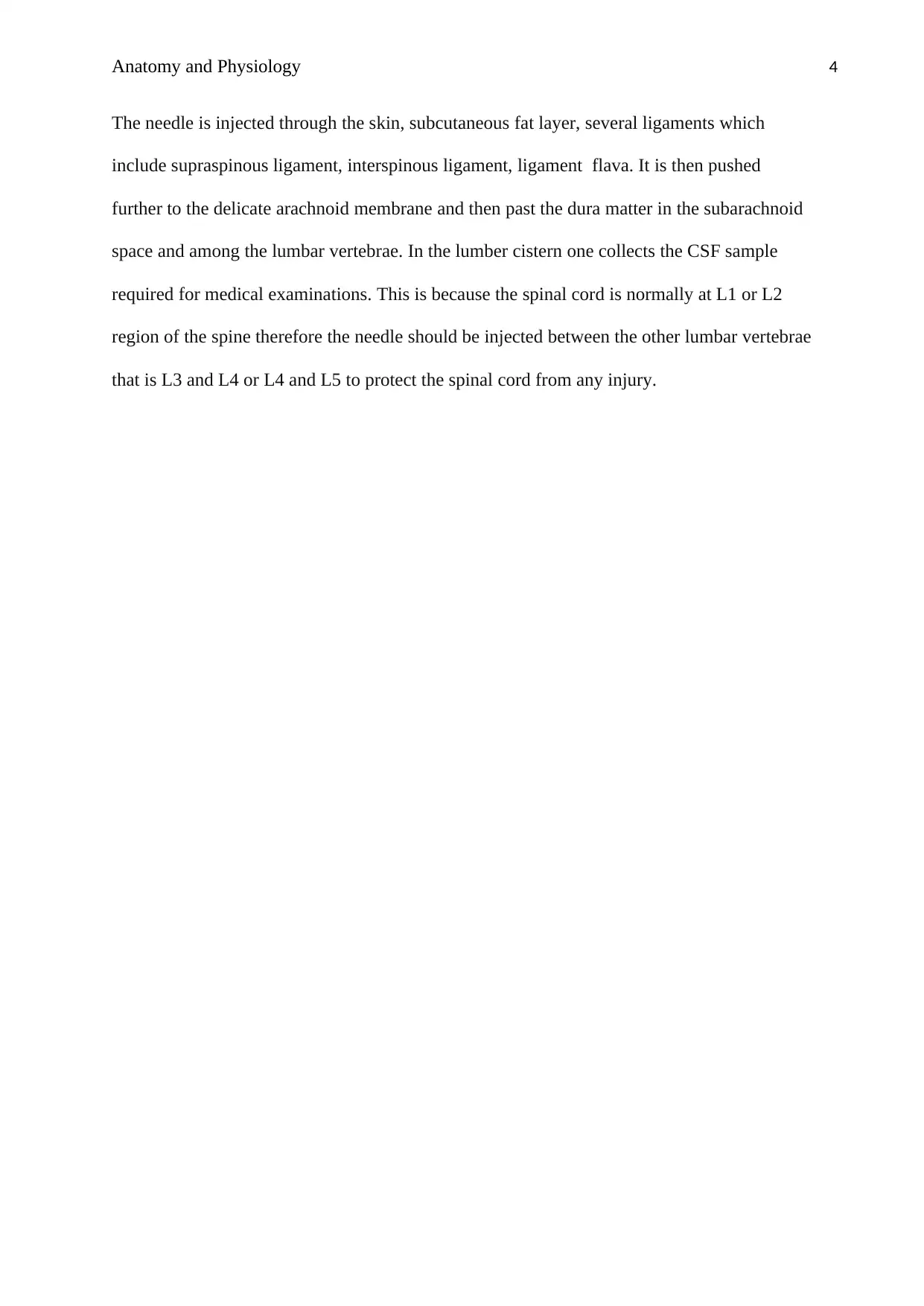
Anatomy and Physiology 4
The needle is injected through the skin, subcutaneous fat layer, several ligaments which
include supraspinous ligament, interspinous ligament, ligament flava. It is then pushed
further to the delicate arachnoid membrane and then past the dura matter in the subarachnoid
space and among the lumbar vertebrae. In the lumber cistern one collects the CSF sample
required for medical examinations. This is because the spinal cord is normally at L1 or L2
region of the spine therefore the needle should be injected between the other lumbar vertebrae
that is L3 and L4 or L4 and L5 to protect the spinal cord from any injury.
The needle is injected through the skin, subcutaneous fat layer, several ligaments which
include supraspinous ligament, interspinous ligament, ligament flava. It is then pushed
further to the delicate arachnoid membrane and then past the dura matter in the subarachnoid
space and among the lumbar vertebrae. In the lumber cistern one collects the CSF sample
required for medical examinations. This is because the spinal cord is normally at L1 or L2
region of the spine therefore the needle should be injected between the other lumbar vertebrae
that is L3 and L4 or L4 and L5 to protect the spinal cord from any injury.
Paraphrase This Document
Need a fresh take? Get an instant paraphrase of this document with our AI Paraphraser
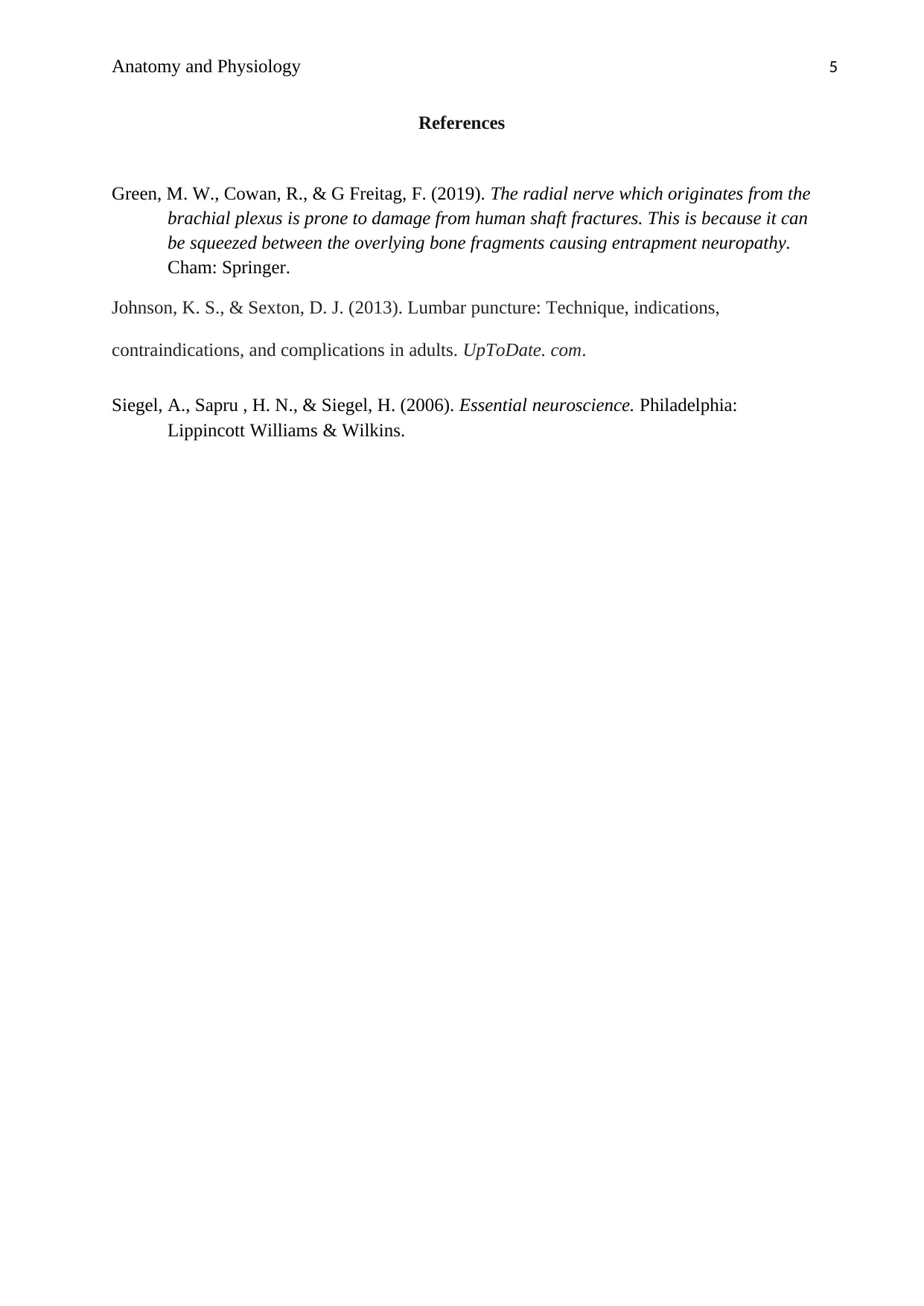
Anatomy and Physiology 5
References
Green, M. W., Cowan, R., & G Freitag, F. (2019). The radial nerve which originates from the
brachial plexus is prone to damage from human shaft fractures. This is because it can
be squeezed between the overlying bone fragments causing entrapment neuropathy.
Cham: Springer.
Johnson, K. S., & Sexton, D. J. (2013). Lumbar puncture: Technique, indications,
contraindications, and complications in adults. UpToDate. com.
Siegel, A., Sapru , H. N., & Siegel, H. (2006). Essential neuroscience. Philadelphia:
Lippincott Williams & Wilkins.
References
Green, M. W., Cowan, R., & G Freitag, F. (2019). The radial nerve which originates from the
brachial plexus is prone to damage from human shaft fractures. This is because it can
be squeezed between the overlying bone fragments causing entrapment neuropathy.
Cham: Springer.
Johnson, K. S., & Sexton, D. J. (2013). Lumbar puncture: Technique, indications,
contraindications, and complications in adults. UpToDate. com.
Siegel, A., Sapru , H. N., & Siegel, H. (2006). Essential neuroscience. Philadelphia:
Lippincott Williams & Wilkins.
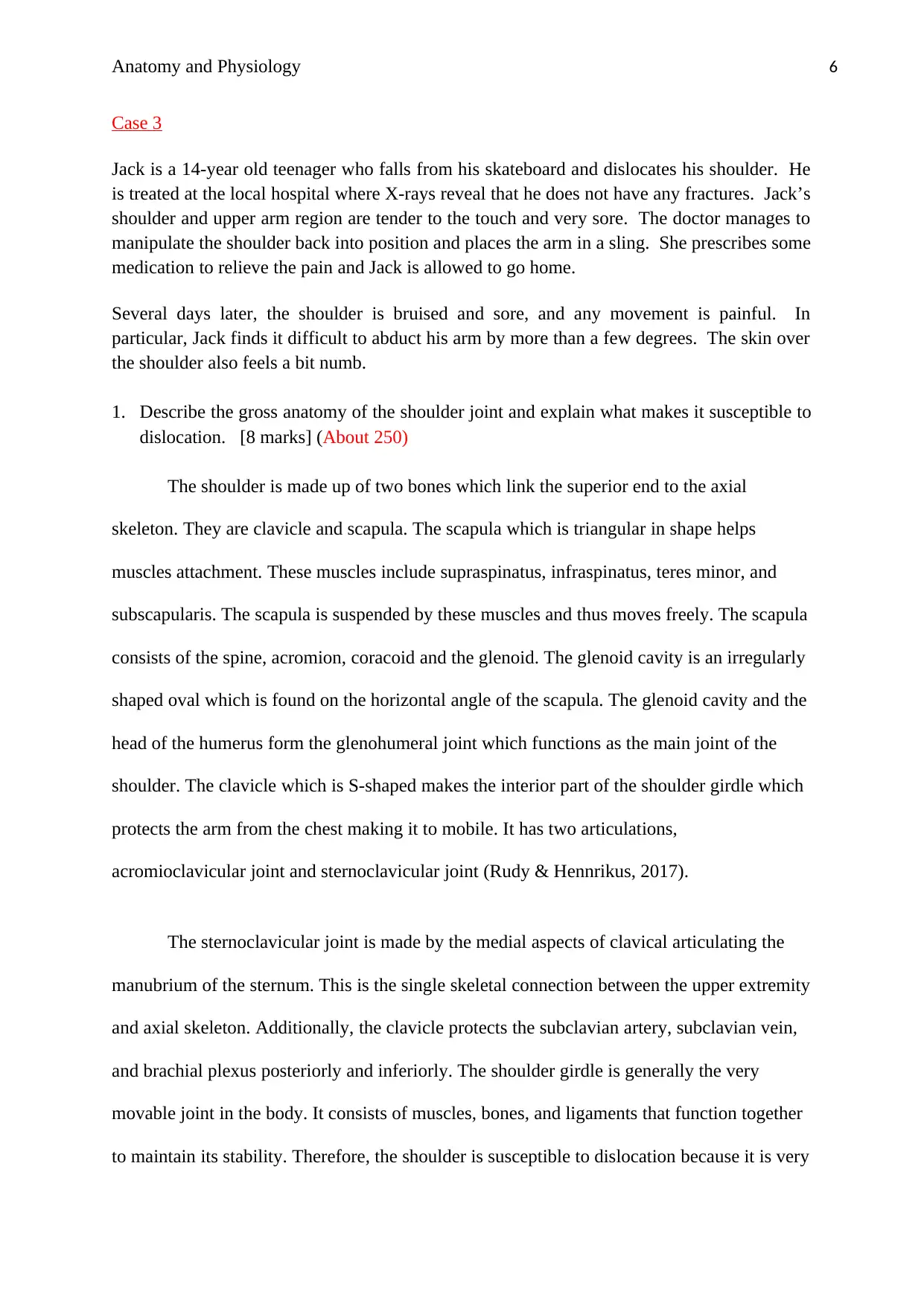
Anatomy and Physiology 6
Case 3
Jack is a 14-year old teenager who falls from his skateboard and dislocates his shoulder. He
is treated at the local hospital where X-rays reveal that he does not have any fractures. Jack’s
shoulder and upper arm region are tender to the touch and very sore. The doctor manages to
manipulate the shoulder back into position and places the arm in a sling. She prescribes some
medication to relieve the pain and Jack is allowed to go home.
Several days later, the shoulder is bruised and sore, and any movement is painful. In
particular, Jack finds it difficult to abduct his arm by more than a few degrees. The skin over
the shoulder also feels a bit numb.
1. Describe the gross anatomy of the shoulder joint and explain what makes it susceptible to
dislocation. [8 marks] (About 250)
The shoulder is made up of two bones which link the superior end to the axial
skeleton. They are clavicle and scapula. The scapula which is triangular in shape helps
muscles attachment. These muscles include supraspinatus, infraspinatus, teres minor, and
subscapularis. The scapula is suspended by these muscles and thus moves freely. The scapula
consists of the spine, acromion, coracoid and the glenoid. The glenoid cavity is an irregularly
shaped oval which is found on the horizontal angle of the scapula. The glenoid cavity and the
head of the humerus form the glenohumeral joint which functions as the main joint of the
shoulder. The clavicle which is S-shaped makes the interior part of the shoulder girdle which
protects the arm from the chest making it to mobile. It has two articulations,
acromioclavicular joint and sternoclavicular joint (Rudy & Hennrikus, 2017).
The sternoclavicular joint is made by the medial aspects of clavical articulating the
manubrium of the sternum. This is the single skeletal connection between the upper extremity
and axial skeleton. Additionally, the clavicle protects the subclavian artery, subclavian vein,
and brachial plexus posteriorly and inferiorly. The shoulder girdle is generally the very
movable joint in the body. It consists of muscles, bones, and ligaments that function together
to maintain its stability. Therefore, the shoulder is susceptible to dislocation because it is very
Case 3
Jack is a 14-year old teenager who falls from his skateboard and dislocates his shoulder. He
is treated at the local hospital where X-rays reveal that he does not have any fractures. Jack’s
shoulder and upper arm region are tender to the touch and very sore. The doctor manages to
manipulate the shoulder back into position and places the arm in a sling. She prescribes some
medication to relieve the pain and Jack is allowed to go home.
Several days later, the shoulder is bruised and sore, and any movement is painful. In
particular, Jack finds it difficult to abduct his arm by more than a few degrees. The skin over
the shoulder also feels a bit numb.
1. Describe the gross anatomy of the shoulder joint and explain what makes it susceptible to
dislocation. [8 marks] (About 250)
The shoulder is made up of two bones which link the superior end to the axial
skeleton. They are clavicle and scapula. The scapula which is triangular in shape helps
muscles attachment. These muscles include supraspinatus, infraspinatus, teres minor, and
subscapularis. The scapula is suspended by these muscles and thus moves freely. The scapula
consists of the spine, acromion, coracoid and the glenoid. The glenoid cavity is an irregularly
shaped oval which is found on the horizontal angle of the scapula. The glenoid cavity and the
head of the humerus form the glenohumeral joint which functions as the main joint of the
shoulder. The clavicle which is S-shaped makes the interior part of the shoulder girdle which
protects the arm from the chest making it to mobile. It has two articulations,
acromioclavicular joint and sternoclavicular joint (Rudy & Hennrikus, 2017).
The sternoclavicular joint is made by the medial aspects of clavical articulating the
manubrium of the sternum. This is the single skeletal connection between the upper extremity
and axial skeleton. Additionally, the clavicle protects the subclavian artery, subclavian vein,
and brachial plexus posteriorly and inferiorly. The shoulder girdle is generally the very
movable joint in the body. It consists of muscles, bones, and ligaments that function together
to maintain its stability. Therefore, the shoulder is susceptible to dislocation because it is very
⊘ This is a preview!⊘
Do you want full access?
Subscribe today to unlock all pages.

Trusted by 1+ million students worldwide
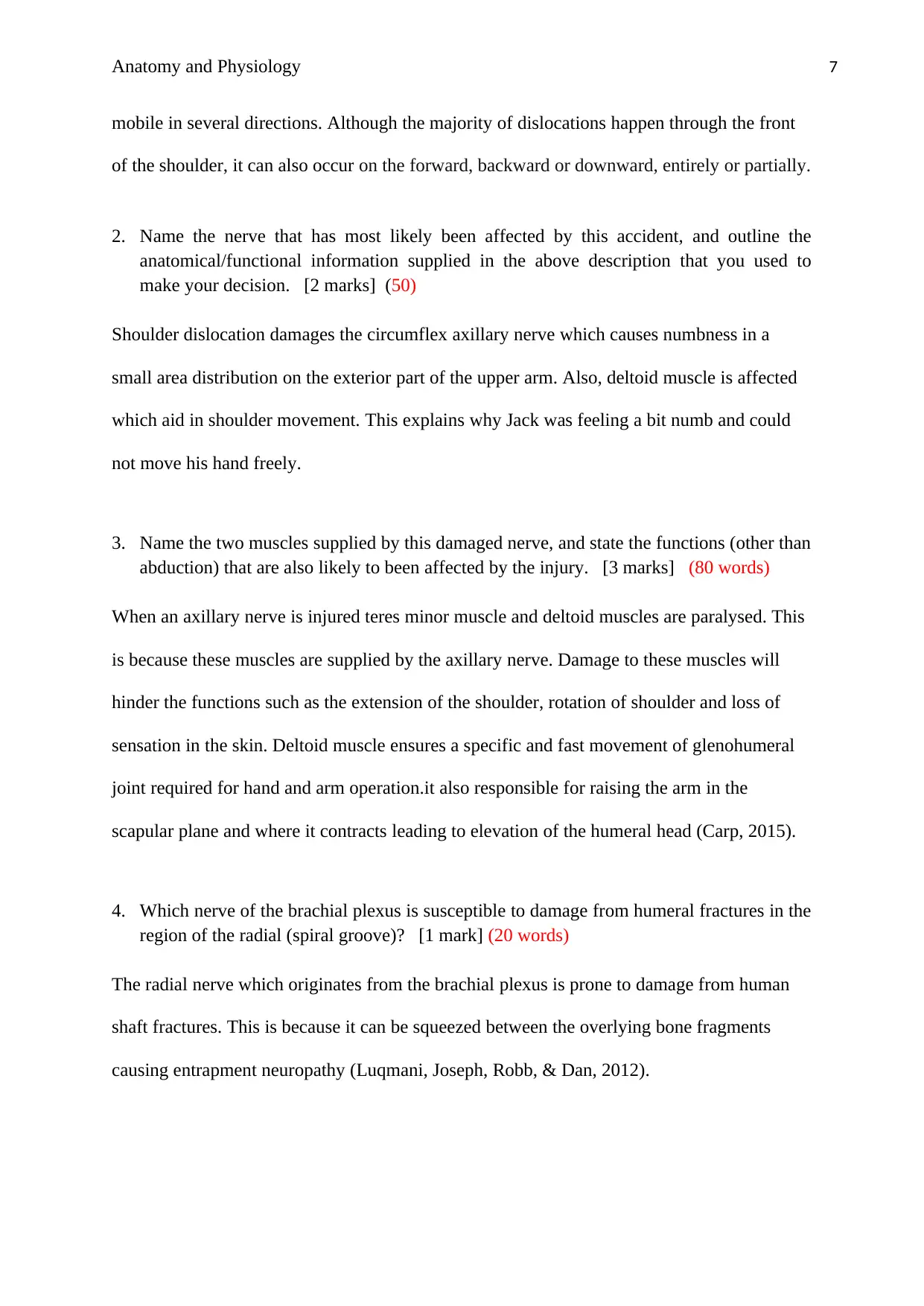
Anatomy and Physiology 7
mobile in several directions. Although the majority of dislocations happen through the front
of the shoulder, it can also occur on the forward, backward or downward, entirely or partially.
2. Name the nerve that has most likely been affected by this accident, and outline the
anatomical/functional information supplied in the above description that you used to
make your decision. [2 marks] (50)
Shoulder dislocation damages the circumflex axillary nerve which causes numbness in a
small area distribution on the exterior part of the upper arm. Also, deltoid muscle is affected
which aid in shoulder movement. This explains why Jack was feeling a bit numb and could
not move his hand freely.
3. Name the two muscles supplied by this damaged nerve, and state the functions (other than
abduction) that are also likely to been affected by the injury. [3 marks] (80 words)
When an axillary nerve is injured teres minor muscle and deltoid muscles are paralysed. This
is because these muscles are supplied by the axillary nerve. Damage to these muscles will
hinder the functions such as the extension of the shoulder, rotation of shoulder and loss of
sensation in the skin. Deltoid muscle ensures a specific and fast movement of glenohumeral
joint required for hand and arm operation.it also responsible for raising the arm in the
scapular plane and where it contracts leading to elevation of the humeral head (Carp, 2015).
4. Which nerve of the brachial plexus is susceptible to damage from humeral fractures in the
region of the radial (spiral groove)? [1 mark] (20 words)
The radial nerve which originates from the brachial plexus is prone to damage from human
shaft fractures. This is because it can be squeezed between the overlying bone fragments
causing entrapment neuropathy (Luqmani, Joseph, Robb, & Dan, 2012).
mobile in several directions. Although the majority of dislocations happen through the front
of the shoulder, it can also occur on the forward, backward or downward, entirely or partially.
2. Name the nerve that has most likely been affected by this accident, and outline the
anatomical/functional information supplied in the above description that you used to
make your decision. [2 marks] (50)
Shoulder dislocation damages the circumflex axillary nerve which causes numbness in a
small area distribution on the exterior part of the upper arm. Also, deltoid muscle is affected
which aid in shoulder movement. This explains why Jack was feeling a bit numb and could
not move his hand freely.
3. Name the two muscles supplied by this damaged nerve, and state the functions (other than
abduction) that are also likely to been affected by the injury. [3 marks] (80 words)
When an axillary nerve is injured teres minor muscle and deltoid muscles are paralysed. This
is because these muscles are supplied by the axillary nerve. Damage to these muscles will
hinder the functions such as the extension of the shoulder, rotation of shoulder and loss of
sensation in the skin. Deltoid muscle ensures a specific and fast movement of glenohumeral
joint required for hand and arm operation.it also responsible for raising the arm in the
scapular plane and where it contracts leading to elevation of the humeral head (Carp, 2015).
4. Which nerve of the brachial plexus is susceptible to damage from humeral fractures in the
region of the radial (spiral groove)? [1 mark] (20 words)
The radial nerve which originates from the brachial plexus is prone to damage from human
shaft fractures. This is because it can be squeezed between the overlying bone fragments
causing entrapment neuropathy (Luqmani, Joseph, Robb, & Dan, 2012).
Paraphrase This Document
Need a fresh take? Get an instant paraphrase of this document with our AI Paraphraser
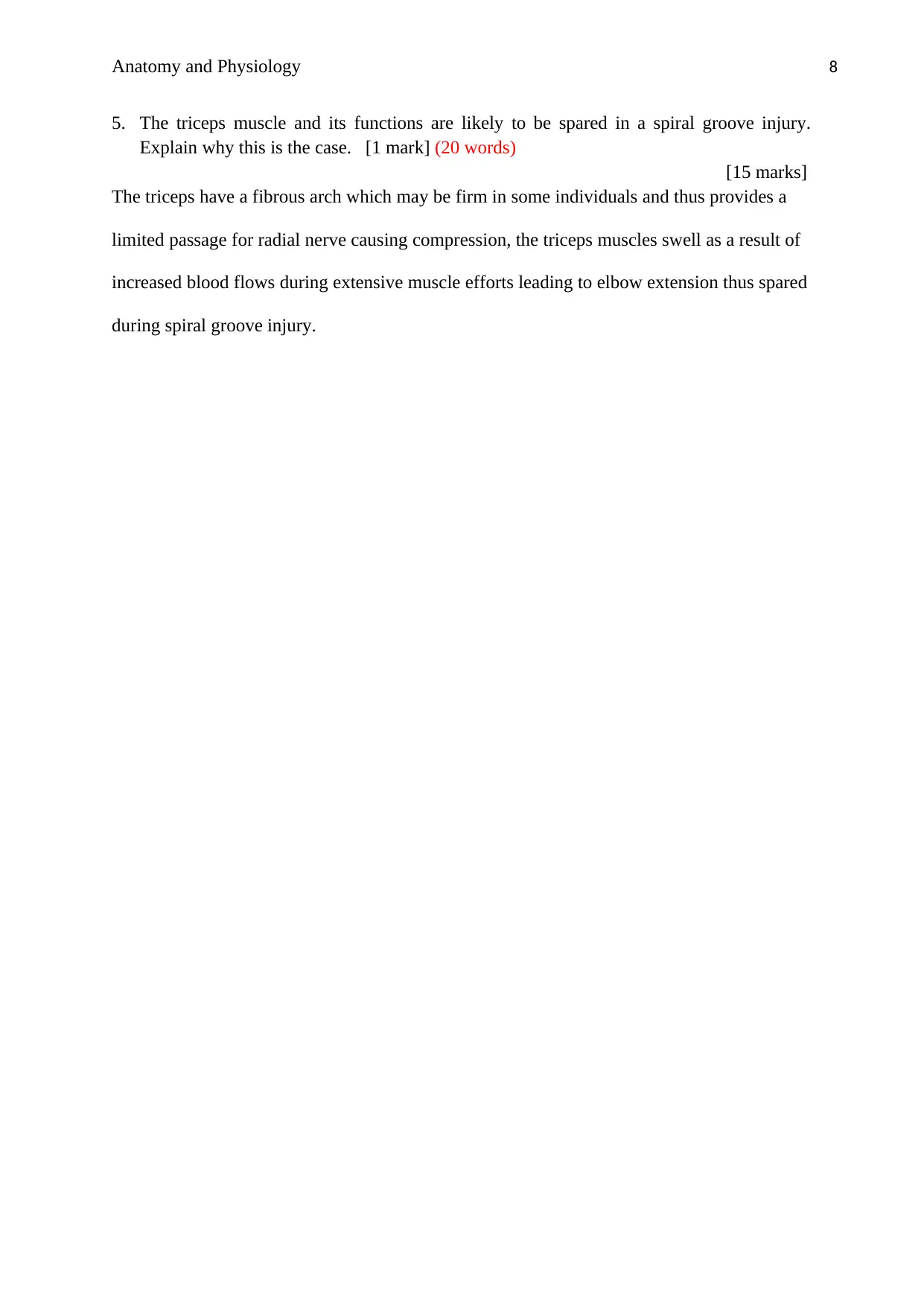
Anatomy and Physiology 8
5. The triceps muscle and its functions are likely to be spared in a spiral groove injury.
Explain why this is the case. [1 mark] (20 words)
[15 marks]
The triceps have a fibrous arch which may be firm in some individuals and thus provides a
limited passage for radial nerve causing compression, the triceps muscles swell as a result of
increased blood flows during extensive muscle efforts leading to elbow extension thus spared
during spiral groove injury.
5. The triceps muscle and its functions are likely to be spared in a spiral groove injury.
Explain why this is the case. [1 mark] (20 words)
[15 marks]
The triceps have a fibrous arch which may be firm in some individuals and thus provides a
limited passage for radial nerve causing compression, the triceps muscles swell as a result of
increased blood flows during extensive muscle efforts leading to elbow extension thus spared
during spiral groove injury.
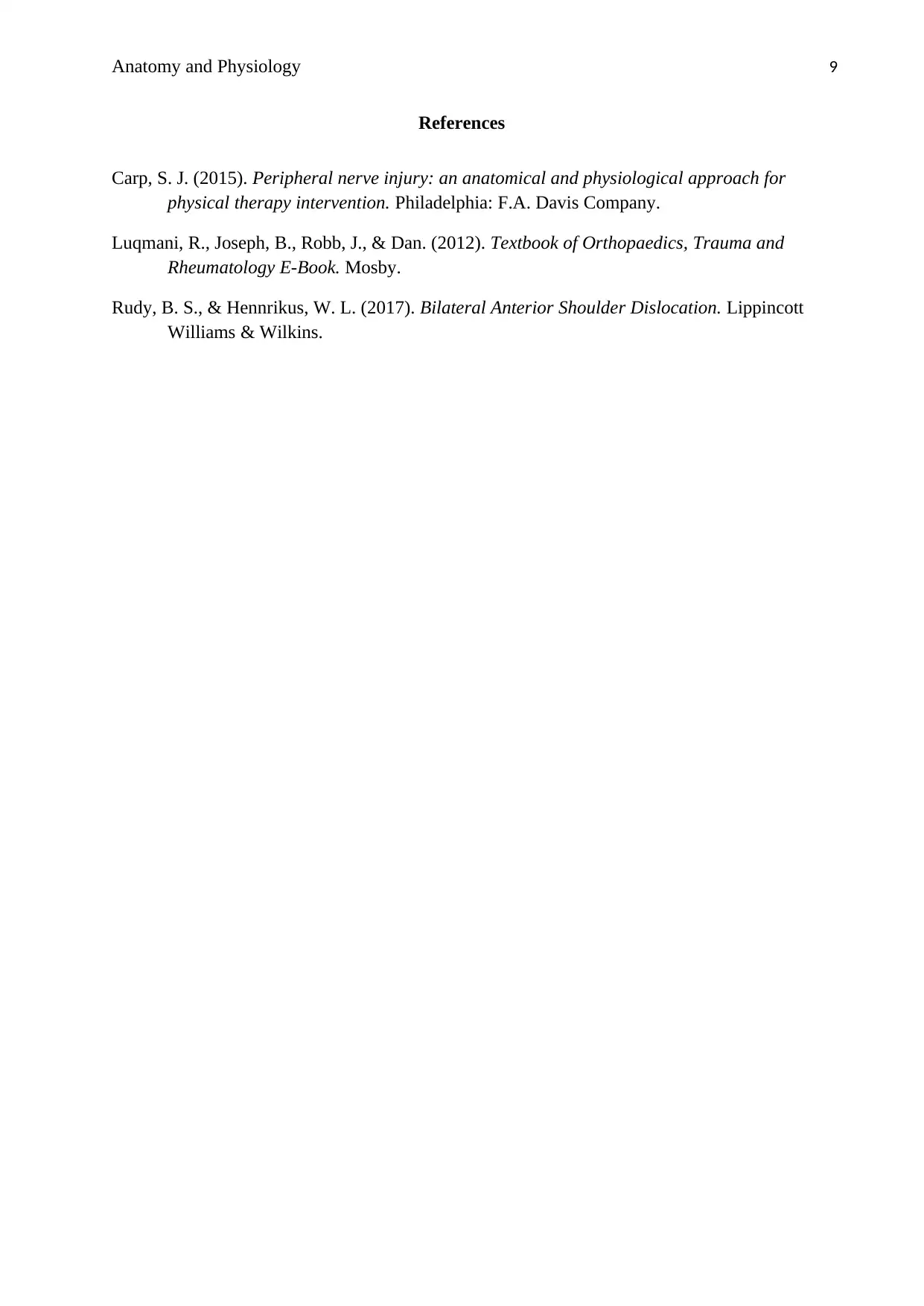
Anatomy and Physiology 9
References
Carp, S. J. (2015). Peripheral nerve injury: an anatomical and physiological approach for
physical therapy intervention. Philadelphia: F.A. Davis Company.
Luqmani, R., Joseph, B., Robb, J., & Dan. (2012). Textbook of Orthopaedics, Trauma and
Rheumatology E-Book. Mosby.
Rudy, B. S., & Hennrikus, W. L. (2017). Bilateral Anterior Shoulder Dislocation. Lippincott
Williams & Wilkins.
References
Carp, S. J. (2015). Peripheral nerve injury: an anatomical and physiological approach for
physical therapy intervention. Philadelphia: F.A. Davis Company.
Luqmani, R., Joseph, B., Robb, J., & Dan. (2012). Textbook of Orthopaedics, Trauma and
Rheumatology E-Book. Mosby.
Rudy, B. S., & Hennrikus, W. L. (2017). Bilateral Anterior Shoulder Dislocation. Lippincott
Williams & Wilkins.
⊘ This is a preview!⊘
Do you want full access?
Subscribe today to unlock all pages.

Trusted by 1+ million students worldwide
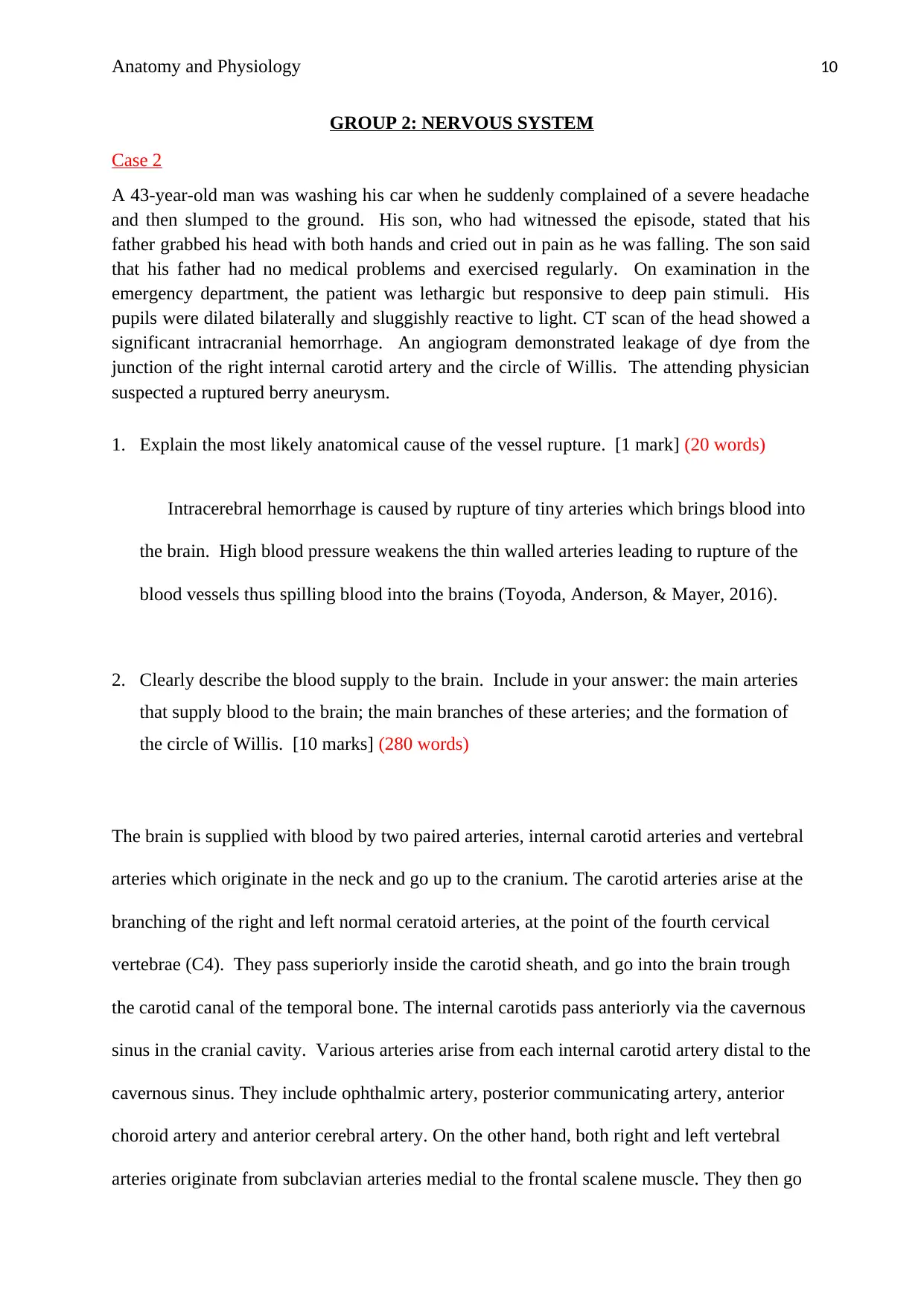
Anatomy and Physiology 10
GROUP 2: NERVOUS SYSTEM
Case 2
A 43-year-old man was washing his car when he suddenly complained of a severe headache
and then slumped to the ground. His son, who had witnessed the episode, stated that his
father grabbed his head with both hands and cried out in pain as he was falling. The son said
that his father had no medical problems and exercised regularly. On examination in the
emergency department, the patient was lethargic but responsive to deep pain stimuli. His
pupils were dilated bilaterally and sluggishly reactive to light. CT scan of the head showed a
significant intracranial hemorrhage. An angiogram demonstrated leakage of dye from the
junction of the right internal carotid artery and the circle of Willis. The attending physician
suspected a ruptured berry aneurysm.
1. Explain the most likely anatomical cause of the vessel rupture. [1 mark] (20 words)
Intracerebral hemorrhage is caused by rupture of tiny arteries which brings blood into
the brain. High blood pressure weakens the thin walled arteries leading to rupture of the
blood vessels thus spilling blood into the brains (Toyoda, Anderson, & Mayer, 2016).
2. Clearly describe the blood supply to the brain. Include in your answer: the main arteries
that supply blood to the brain; the main branches of these arteries; and the formation of
the circle of Willis. [10 marks] (280 words)
The brain is supplied with blood by two paired arteries, internal carotid arteries and vertebral
arteries which originate in the neck and go up to the cranium. The carotid arteries arise at the
branching of the right and left normal ceratoid arteries, at the point of the fourth cervical
vertebrae (C4). They pass superiorly inside the carotid sheath, and go into the brain trough
the carotid canal of the temporal bone. The internal carotids pass anteriorly via the cavernous
sinus in the cranial cavity. Various arteries arise from each internal carotid artery distal to the
cavernous sinus. They include ophthalmic artery, posterior communicating artery, anterior
choroid artery and anterior cerebral artery. On the other hand, both right and left vertebral
arteries originate from subclavian arteries medial to the frontal scalene muscle. They then go
GROUP 2: NERVOUS SYSTEM
Case 2
A 43-year-old man was washing his car when he suddenly complained of a severe headache
and then slumped to the ground. His son, who had witnessed the episode, stated that his
father grabbed his head with both hands and cried out in pain as he was falling. The son said
that his father had no medical problems and exercised regularly. On examination in the
emergency department, the patient was lethargic but responsive to deep pain stimuli. His
pupils were dilated bilaterally and sluggishly reactive to light. CT scan of the head showed a
significant intracranial hemorrhage. An angiogram demonstrated leakage of dye from the
junction of the right internal carotid artery and the circle of Willis. The attending physician
suspected a ruptured berry aneurysm.
1. Explain the most likely anatomical cause of the vessel rupture. [1 mark] (20 words)
Intracerebral hemorrhage is caused by rupture of tiny arteries which brings blood into
the brain. High blood pressure weakens the thin walled arteries leading to rupture of the
blood vessels thus spilling blood into the brains (Toyoda, Anderson, & Mayer, 2016).
2. Clearly describe the blood supply to the brain. Include in your answer: the main arteries
that supply blood to the brain; the main branches of these arteries; and the formation of
the circle of Willis. [10 marks] (280 words)
The brain is supplied with blood by two paired arteries, internal carotid arteries and vertebral
arteries which originate in the neck and go up to the cranium. The carotid arteries arise at the
branching of the right and left normal ceratoid arteries, at the point of the fourth cervical
vertebrae (C4). They pass superiorly inside the carotid sheath, and go into the brain trough
the carotid canal of the temporal bone. The internal carotids pass anteriorly via the cavernous
sinus in the cranial cavity. Various arteries arise from each internal carotid artery distal to the
cavernous sinus. They include ophthalmic artery, posterior communicating artery, anterior
choroid artery and anterior cerebral artery. On the other hand, both right and left vertebral
arteries originate from subclavian arteries medial to the frontal scalene muscle. They then go
Paraphrase This Document
Need a fresh take? Get an instant paraphrase of this document with our AI Paraphraser
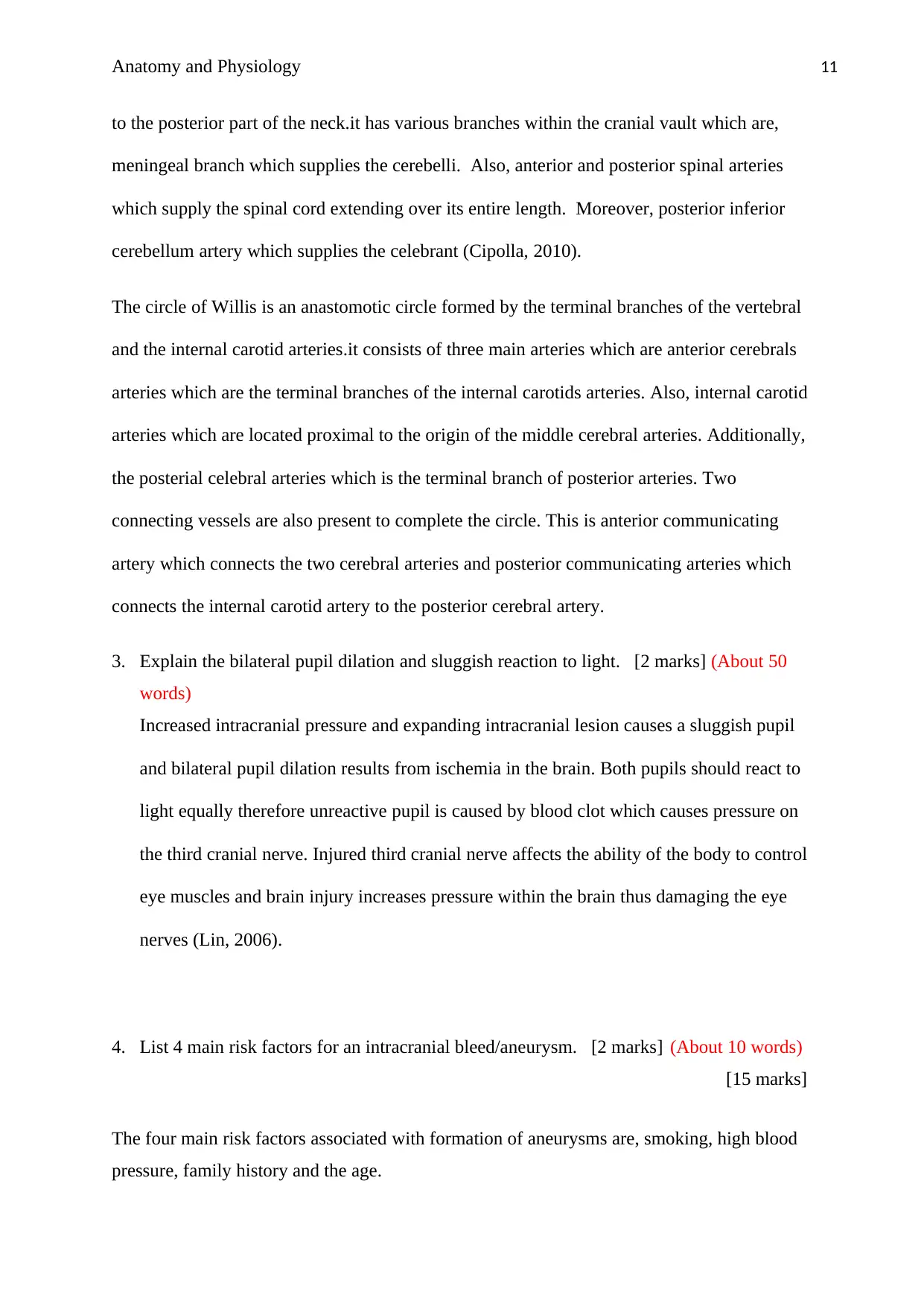
Anatomy and Physiology 11
to the posterior part of the neck.it has various branches within the cranial vault which are,
meningeal branch which supplies the cerebelli. Also, anterior and posterior spinal arteries
which supply the spinal cord extending over its entire length. Moreover, posterior inferior
cerebellum artery which supplies the celebrant (Cipolla, 2010).
The circle of Willis is an anastomotic circle formed by the terminal branches of the vertebral
and the internal carotid arteries.it consists of three main arteries which are anterior cerebrals
arteries which are the terminal branches of the internal carotids arteries. Also, internal carotid
arteries which are located proximal to the origin of the middle cerebral arteries. Additionally,
the posterial celebral arteries which is the terminal branch of posterior arteries. Two
connecting vessels are also present to complete the circle. This is anterior communicating
artery which connects the two cerebral arteries and posterior communicating arteries which
connects the internal carotid artery to the posterior cerebral artery.
3. Explain the bilateral pupil dilation and sluggish reaction to light. [2 marks] (About 50
words)
Increased intracranial pressure and expanding intracranial lesion causes a sluggish pupil
and bilateral pupil dilation results from ischemia in the brain. Both pupils should react to
light equally therefore unreactive pupil is caused by blood clot which causes pressure on
the third cranial nerve. Injured third cranial nerve affects the ability of the body to control
eye muscles and brain injury increases pressure within the brain thus damaging the eye
nerves (Lin, 2006).
4. List 4 main risk factors for an intracranial bleed/aneurysm. [2 marks] (About 10 words)
[15 marks]
The four main risk factors associated with formation of aneurysms are, smoking, high blood
pressure, family history and the age.
to the posterior part of the neck.it has various branches within the cranial vault which are,
meningeal branch which supplies the cerebelli. Also, anterior and posterior spinal arteries
which supply the spinal cord extending over its entire length. Moreover, posterior inferior
cerebellum artery which supplies the celebrant (Cipolla, 2010).
The circle of Willis is an anastomotic circle formed by the terminal branches of the vertebral
and the internal carotid arteries.it consists of three main arteries which are anterior cerebrals
arteries which are the terminal branches of the internal carotids arteries. Also, internal carotid
arteries which are located proximal to the origin of the middle cerebral arteries. Additionally,
the posterial celebral arteries which is the terminal branch of posterior arteries. Two
connecting vessels are also present to complete the circle. This is anterior communicating
artery which connects the two cerebral arteries and posterior communicating arteries which
connects the internal carotid artery to the posterior cerebral artery.
3. Explain the bilateral pupil dilation and sluggish reaction to light. [2 marks] (About 50
words)
Increased intracranial pressure and expanding intracranial lesion causes a sluggish pupil
and bilateral pupil dilation results from ischemia in the brain. Both pupils should react to
light equally therefore unreactive pupil is caused by blood clot which causes pressure on
the third cranial nerve. Injured third cranial nerve affects the ability of the body to control
eye muscles and brain injury increases pressure within the brain thus damaging the eye
nerves (Lin, 2006).
4. List 4 main risk factors for an intracranial bleed/aneurysm. [2 marks] (About 10 words)
[15 marks]
The four main risk factors associated with formation of aneurysms are, smoking, high blood
pressure, family history and the age.
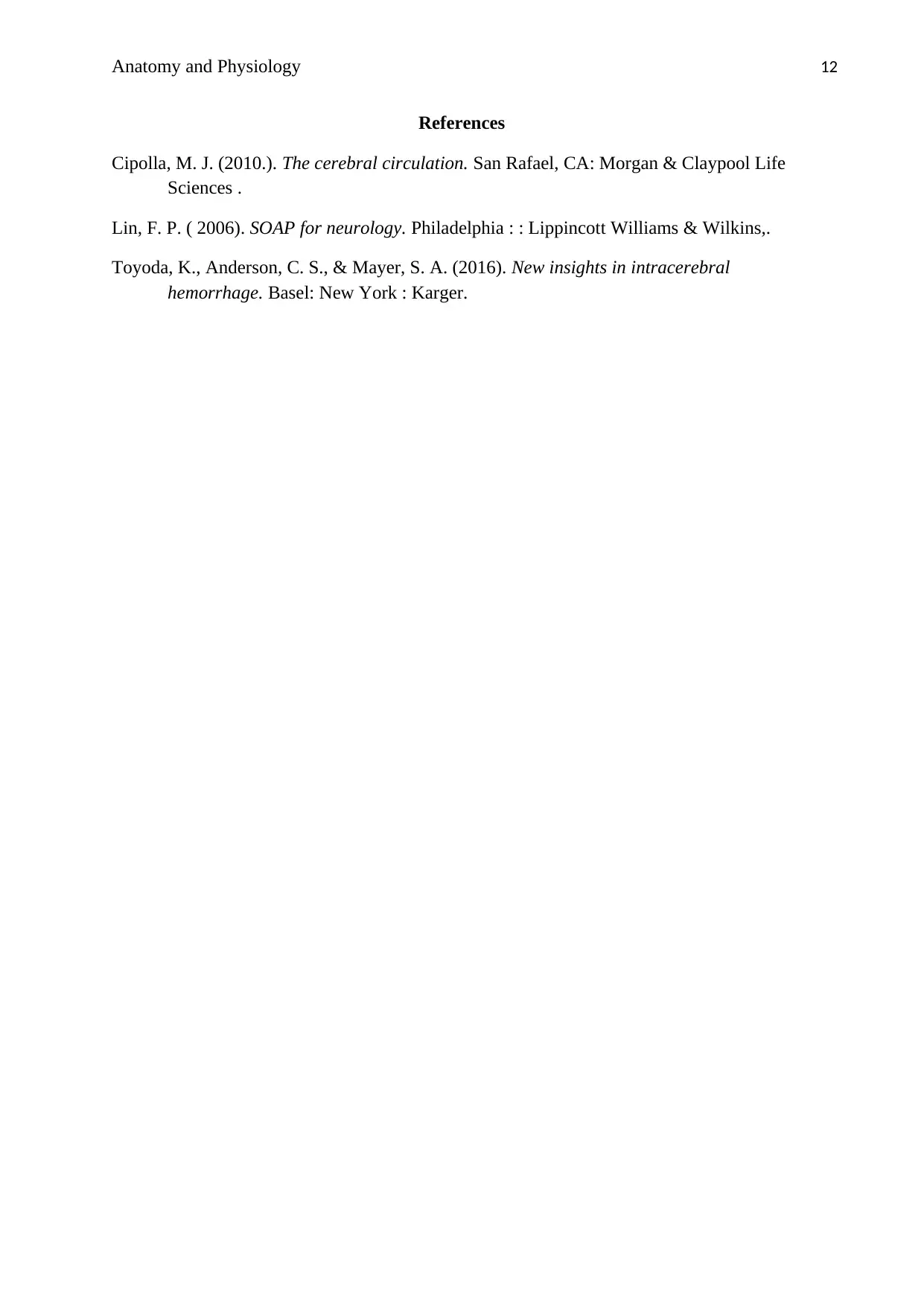
Anatomy and Physiology 12
References
Cipolla, M. J. (2010.). The cerebral circulation. San Rafael, CA: Morgan & Claypool Life
Sciences .
Lin, F. P. ( 2006). SOAP for neurology. Philadelphia : : Lippincott Williams & Wilkins,.
Toyoda, K., Anderson, C. S., & Mayer, S. A. (2016). New insights in intracerebral
hemorrhage. Basel: New York : Karger.
References
Cipolla, M. J. (2010.). The cerebral circulation. San Rafael, CA: Morgan & Claypool Life
Sciences .
Lin, F. P. ( 2006). SOAP for neurology. Philadelphia : : Lippincott Williams & Wilkins,.
Toyoda, K., Anderson, C. S., & Mayer, S. A. (2016). New insights in intracerebral
hemorrhage. Basel: New York : Karger.
⊘ This is a preview!⊘
Do you want full access?
Subscribe today to unlock all pages.

Trusted by 1+ million students worldwide
1 out of 12
Your All-in-One AI-Powered Toolkit for Academic Success.
+13062052269
info@desklib.com
Available 24*7 on WhatsApp / Email
![[object Object]](/_next/static/media/star-bottom.7253800d.svg)
Unlock your academic potential
Copyright © 2020–2025 A2Z Services. All Rights Reserved. Developed and managed by ZUCOL.